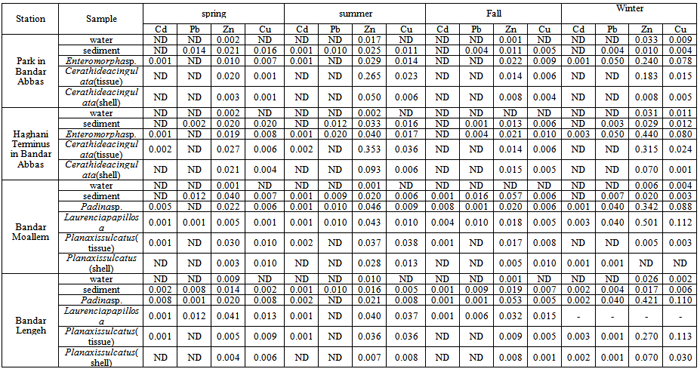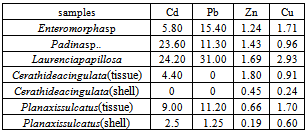-
Paper Information
- Paper Submission
-
Journal Information
- About This Journal
- Editorial Board
- Current Issue
- Archive
- Author Guidelines
- Contact Us
Marine Science
p-ISSN: 2163-2421 e-ISSN: 2163-243X
2013; 3(2): 39-47
doi:10.5923/j.ms.20130302.01
Heavy Metals in Water, Sediment and Macrobenthos in the Interdidal Zone of Hormozgan Province, Iran
Parisa Nejatkhah Manavi
Faculty of Marine Science and Technology, Islamic Azad Universty, North Tehran Branch No.14, Shahid Falahi st., Valiy-e-Asr st. , Tehran, Iran
Correspondence to: Parisa Nejatkhah Manavi , Faculty of Marine Science and Technology, Islamic Azad Universty, North Tehran Branch No.14, Shahid Falahi st., Valiy-e-Asr st. , Tehran, Iran.
| Email: |  |
Copyright © 2012 Scientific & Academic Publishing. All Rights Reserved.
The present study was conducted in the intertidal zones of Hormozgan Province at four different stations. Samplings were carried out on a seasonal basis from April 2007 through February in 2008.The aim of the present study was to monitor the heavy metal concentration in water, sediment, macroalgae and gastropods. For this purpose, three macroalgae, (Padinasp. (Phaeophyta), Laurenciapapillosa (Rhodophyta) and Enteromophasp.(Chlorophyta))and two gastropods shell and tissues (Planaxissulcatus(Born, 1780) and Cerathideacingulata (Gmelin, 1791)) were collected and the levels of zinc, copper, lead and cadmium were measured. Heavy metal concentration was in the order of Zn>Cu>Cd>Pb throughout the year.The results showed that the sediment concentrated more heavy metals than the water while all macrobenthoses accumulated more of these metals than the sediment. The concentration of heavy metals in the tissue of gastropods was also generally more than that of the shell concentration. The highest accumulation of heavy metals was observed in winter. Biological Concentration Factor (BCF) values revealed that Laurenciapapillosa and Padinasp. have high potential to concentrate Pb and Cd, and the accumulation potential of Planaxissulcatus for metals was higher than that Cerathideacingulata. The concentrations of heavy metals in the examined species in this study, which is the first of its kind in this region of Iran, indicate anunpolluted environment as all the metals analyzed were within the safety level.
Keywords: Macroalgae, Gastropod, Heavy Metals, Bioaccumulation, Persian Gulf
Cite this paper: Parisa Nejatkhah Manavi , Heavy Metals in Water, Sediment and Macrobenthos in the Interdidal Zone of Hormozgan Province, Iran, Marine Science, Vol. 3 No. 2, 2013, pp. 39-47. doi: 10.5923/j.ms.20130302.01.
1. Introduction
- The non-degradability of inorganic pollutants like heavy metals creates a hazard when they are discharged into a water body. The oceans provide a vital sink for many heavy metals and their compounds. There is a growing concern that the natural cycling rates of many metals are being disturbed by anthropogenic activities, especially the release from industrial, domestic and urban effluents of increasing amounts of Pb, Zn, Cd, and Cu[47].Assessment of heavy metal concentration in the coastal waters can be made by using indicator organisms, particularly algae[32,52,3,27,39] and molluscs[25,29,17,12] which accumulate pollutants proportionally to their environmental concentration[30].It is known that algae and mollusks accumulate organic and metallic pollutants at concentrations several orders of magnitude above those observed in the field environment and some of them are also considered as useful biomonitors of certain metals[12,51,24].The Persian Gulf is a very important navigational industrial area. It lies between latitude 23.9°- 30.25° N and longitude 48°-56°-2.0’. It is a shallow area with a depth ranging between 10 and 100m. This aquatic ecosystem which has recently faced with different pollutions and its ecology has come under pressure from industrialization, discharge of wasteand in particular, petroleum spillage during the recent wars in the region[1]. Hormozgan province is in the south of Iran, facing Persian Gulf and Oman Sea. Some studies have been carried out to understand the physiochemical or biological characteristics of the environment of Hormozgan province[18,19].Other studies describe macroalgae[49,42] phytoplankton[43]macrobenthos[53,22] and aquaculture[4,11] but still a few findings exist about the extent of pollution and especially that of heavy metals in this area[26,35,1,2,44]. All these studies provides general baseline information while some attempted to explain the possible effects of industrial discharges on this aquatic environment. The present study was conducted in order to monitor and investigate the accumulation of heavy metals, in water, sediments and macrobenthic organisms in the intertidal zones of Hormozgan Province in Persian Gulf in Iran.
2. Materials and Methods
- The samples were collected on a seasonal basis from April 2007 through February in 2008 from four different locations in the intertidal regions of Hormozgan Province in the Persian Gulf. The sampling stations were chosen based on ecological settings and human activities in the area. Two stations were located in Bandar Abbas with muddy shore; one of them is located in the Haghani terminus, a busy spot where a lot of shipping vessels commute and the other in the coastal park far from industrial activities and transportation of fishing vessels. The third station was located in Bandar Moallem, where there is not much industrial or anthropogenic activity and the fourth station was in Bandar Lengeh, where sewage was discharged and fishing vessels commuted. The two last stations (Bandar Moallem and Bandar Lengeh) had rocky shores (Fig. 1).Trace metal content (zinc, cadmium, lead and copper) were analyzed in the water, sediment, green algae Enteromopha sp., soft tissue and shell of Cerathideacingulata in Haghani terminus and park in Bandar Abbas and brown algae Padina sp., red algae Laurenciapapillosa, soft tissue and shell of Planaxissulcatus in Bandar Moallem and Bandar Lengeh. Thesamplings were carried out on a transect line, 10 to 20 m in width (depending on the region and about 500m2) in each location.About 500 g fresh weights of algal masses were harvested at low tide. The samples were washed in sea water at the sampling site and transferred in plastic bags to the laboratory at the same day in refrigerated conditions. They were cleaned in sea water to remove sand, particulate matter and epiphytes at the laboratory. Finally the samples were rinsed in tap and distilled water and stored at -18℃ at the Atomic Energy Organization of Iran until they were analyzed[15,32,51].All samples were done in 3 replicates. The samples were dried at 110℃ and subject to wet digestion. 1 g of sample (dry weight) was put into a glass beaker, 5 ml H2So4 added and heated to 80℃. Then, HNO3 was added and heating continued to 120℃ for 30 min. Nexthydrogen peroxide was added until the solution remained clear. Then the solution was diluted to 100 ml with 2% HNO3[41].The top 20cm of the bottom sediment wassampled from each sampling station and kept in glass bottles (about 200g). The sediment samples were later processed following standard methods[9]. The water samples were collected at all stations at a depth of 50 cm below the surface. They were treated and analyzed for heavy metals using appropriate methods[28]. The gastropod samples (Planaxissulcatus and Cerathideacingulata) were randomly collected by handpicking. Samples were immediately washed with sea water to remove mud and algae,. They were kept in plastic containers, packed in iced chest box and transferred to the laboratory. The soft tissue was removed from the shells with a plastic knife and dried at 60℃. The dried tissue was reduced into fine powder using pestle and mortar and was then stored in desiccator for further analysis. The shell of individual samples was also finely ground.The resulting powder was filtrated using a plastic sieve with 0.2mm openings and was stored in desiccator for further analysis[25,17].Analyses of samples were carried out by the use of ICP- MS at the Atomic Energy Organization, Iran. The Bioconcentration Factor (BCF)was calculated for quantifying the metal accumulation potential of the organisms. The BCF is defined as the ratio of chemical concentration in the organism to that in the surrounding water[40,27].One-way analysis of variance (ANOVA) was used by SPSS (ver.16.0) to evaluate the inter-specific significance between metal accumulation and between metal levels in water, sediment, algae and molluscs and at different sites at 0.05 level of significance.
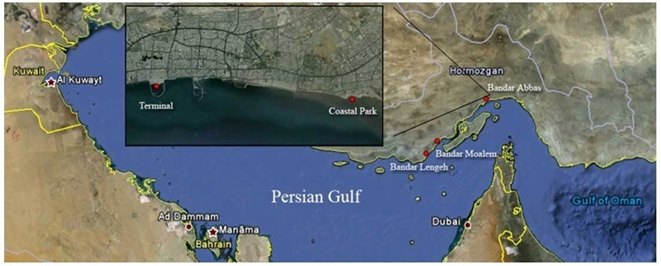 | Figure 1. Map of the study area showing the sampling stations |
|
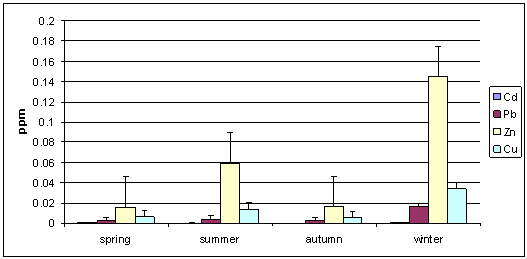 | Figure 2. Cumulative levels of heavy metals for all stations in seasons. Lines indicate SE |
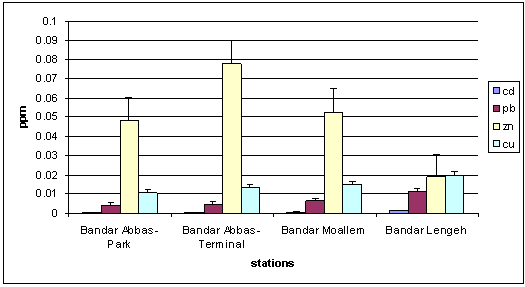 | Figure 3. Mean levels of heavy metals (water, sediment, algae and mollusc) in the sampling sites. Lines indicate SE |
 | Figure 4. Cumulative levels of heavy metalsin algae and molluscs (shells and tissues) in all sampling stations in a year. Lines indicate SE |
3. Results
- The results of the levels of concentration of heavy metals in the water, sediments, algae, shells and soft tissues of gastropods are presented in Tables 1. The only algal group identified in the Bandar Abbas coast with a clayey shore was the green algae(Enteromorphasp.). The mean values of metals were significantly lower in spring and autumn (0.006 ppm) becoming maximum in winter (0.049 ppm) (Fig. 2).Fig. 2 refer to the mean of heavy metals (water, sediment, algae and gastropods) in studied area during a year and fig. 3 showsmean levels of heavy metals in sampling sites in a year.The results showed that the concentrations of copper (0.034 ppm) and zinc (0.145 ppm) were significantly higher in winter, while concentrations of cadmium were not significantly different in all the year (Fig. 2). Concentration of lead was significantly higher in winter (0.025 ppm) vs. spring (0.002 ppm). It is evident from the results of the present study that C. cingulata,P. sulcatus, allmacro algae and sediments accumulated more heavy metals than water. In red algae L. papillosa accumulation of Zn (0.108ppm), Cu (0.029 ppm) and Cd (0.002ppm) were significantly higher from that in water (0.009, 0.002, 0ppm) and sediments (0.022, 0.008, 0.001ppm), respectively. There were no significant difference in lead’s concentrations in gastropods . Cadmium concentrations in algae and animals were significantly higher than in water and sediments, but it was insignificant between algae and gastropods. There were significant difference between heavy metals concentrations among the samplingstations .(Fig. 3 &4) with the highest mean concentration in Haghani terminus in Bandar Abbas (0.037 ppm) and the lowest in Bandar Moallem (0.024 ppm).Maximum concentration of Zn and Cu were in Haghani terminus in Bandar Abbas and Bandar Lengeh (0.078 and 0.020 ppm), respectively (Fig 3). The concentration of heavy metals in the tissue of C. cingulata andP. sulcatuswas also higher than that in theshell. Significant difference was observed in Zn and Cu concentration in C. cingulata tissue (0.149 and 0.148ppm) and shell (0.33 and 0.004ppm), respectively (Fig 4). The order of heavy metals concentrations in green algae, Enteromorphasp. and red algae L. papillosa decreased in the following order: Zn>Cu>Pb>Cd and in C. cingulata, P. sulcatus (tissue and shells) and brown algae Padinasp. were Zn>Cu>Cd>Pb. The order of heavy metals concentrations in sediments of two first stations in Bandar Abbas were Zn>Cu>Pb>Cd but in sediments in Bandar Moallem and Bandar Lengeh were Zn>Pb>Cu>Cd. The highest mean concentration of heavy metals was in Haghani terminus in Bandar Abbasand the lowest level was inBandar Moallem in Bandar Lengeh (Fig.3). The mean metal concentration of heavy metals decreased in the following order of Zn>Cu>Cd>Pb.The biological concentration factor BCFs for Pb, Cd, Cu and Zn in Enteromorpha sp., C. cingulata(tissue and shell), padina sp., L. papillosaandP. sulcatus(tissue and shell) are shown in Table 1.
|
4. Discussion and Conclusions
- The sediments accumulated more heavy metals than the water in this study as have been observed by Oryan et al.[38], Davis et al.[17] and Fabris et al.[21]. The results of the present study revealed the bioaccumulation of zinc, copper, lead and cadmium, in the macroalgae, gastropods and sediment, however due to the lack of sufficient existing information on the status of heavy metals in the region, the comparison of these results with that of previous investigators, which are mostly related to fisheries, is not possible. Oryanet al.[38] reported a mean cadmium concentration of 0.074 ppm in sediments collected from Bandar Lengeh, which was higher than the WHO limit. Cadmium concentration (0.0001 ppm) in the present study was lower than that reported by Oryanet al.[38]. In that study lead’s concentration in sediment was reported as 11.11 µg/g. Mean lead concentration in sediments in the present study was lower (9.8 µg/g)and lower than the WHO limit (19 µg/g).Saeidi et al.[44] reported that the mean Zn in a demersal fish, spangled emperor (Lethrinusnebulosus) in bandar Abbas and Bandar Lengeh was less than those reported from other regions of the Persian Gulf (Qatar, Oman and UAE). Based on their results, the Zn content in fish samples was not sufficient to cause toxic effects on human health[44]. Considering the absence of large industries in Bandar Lengeh, it seems that heavy metal pollution in the area, although lower than the Maximum Allowable Concentration (MAC), is caused by the wastewater discharge and the passage of boats and fishing vessels.The order of heavy metals concentrations in the stations was Haghani terminus in Bandar Abbas>Bandar Lengeh> Park in Bandar Abbas> Bandar Moallem. As the results indicate, the highest concentration of metals was in Haghani terminus in Bandar Abbas (Iran’s busy port) in HormozganProvince which receives effluent from human activities and industries. Concentrations of heavy metals in the present study were slightly higher in summer than in spring (Fig 2) although the differences were not significant. Heavy metal concentrations significantly increased in winter (Fig 2) which can be ascribed to erosion and run-off mechanisms as a result of rainfall during this season in the study area. Minerals, salinity and the proximity of macroalgae to the area where discharge of untreated sewage occurs, are among the factors that influence the toxic effects of heavy metals on macroalgae. Macroalgae are capable of accumulating higher levels of heavy metals. Nutrient loads from sewage promote the growth of macroalgae and thereby remove toxic compounds from wastewater. This phenomenon has been documented in the Padinagymnosporaand Gracilariasp. [32].The comparison of the accumulation of heavy metals in Padina showed higher mean concentrations of zinc in the algal specimens found at the point of entry of wastewater effluents than in those found in non-polluted regions[34]. These findings conform to the results of the present study for the brown algae Padinasp. found in both sampling points of Bandar Lengeh and Bandar Moalem but concentration of Zn was higher inPandina sp. in Bandar Lengeh (0.132ppm) (with discharge of wastewater) than Padina sp.in Bandar Moallem(0.107ppm). The relations between heavy metals accumulated and algae have been discussed by many authors. It has been shown that Pb accumulated at high levels in red, brown and green algae[48,51] Cu in green Sawidis & Voulgaropoulos, [45] and[51], Cu and Zn in brown and red[48,51]. Mamboyaet al.[33] found that metal accumulation in brown algae was greater than that in green algae. These results are similar to the findings of the present study, in particular in winter when the concentrations of heavy metals in the region were higher, as their concentration were higher in brown algae than in green algae. Being sensitive to cold weather, red algae were not found growing in the study area in winter. However L. papillosa, a red algal species found during spring, summer and autumn in the study area was seen to accumulate higher concentrations of heavy metals than other algae. Our results were in good agreement with those reported by El Sayed and Dorgham[20] for the Cd and Zn content in L. papillosa from Qatar coastal water; Aboul-Naga,[3] for the accumulation of Cu and Zn in L. papillosa in Red Sea and Olgunoğlu and Polat[37] for the Cd, Cu and Pb content in L. papillosain Iskenderun Bay in Turkey.In the present study as also in most other investigations, heavy metal concentrations in water and their accumulation in algae exhibited monthly fluctuations although there was no definite trend. This may be attributed to the differences in the amount of discharge of untreated sewage and/or water circulations. Also young macroalgae that grow in the region accumulated lower amounts of heavy metals[34]. Low concentrations were found in spring (Table 1), when the biomass reached its maximum. It has been shown[36] that the abundance and density of L. papillosaand Enteromorphasp. in the studied area increases from October until May. The increase in the biomass led to a decrease in the metal content per unit biomass due to dilution. A similar pattern of seasonal variation, explained by the effect of dilution due to growth, has been observed in other cases such as Cd and Cu in Ulvarigida[23], Cu and Mg in Dasycladusvermicularis, Zn in Fucusvesiculosusand Cd and Ni in Halimenda tuna[46,31]. The diversity of algae was very low in the Bandar Abbas with clayey shores and the major group that identified was the filamentous green algae includeEnteromorphasp., Chaetomorphagracilis, C. prolifera, and Cladophorasp. in all the year withEnteromorphasp. the most abundant. Our results (Table 1) clearly indicate that Enteromorphasp. has a greatability to accumulate Zn and there was a significant difference in Cu, Pb and Cd concentration (p<0.05).So, Enteromorphasp. could be used as a bio-indicator for Zn in this area. The species of Enteromorphaand Cladophoraare known to grow in freshwater and marine habitats and they are used all over the world as indicators of heavy metal pollution in both habitats[50,7]. Our results are similar to studies in the Saudi coast of Persian Gulf on green, brown and red algae which showed that Enteromorphaintestinalis could be used as an excellent indicator for manganese, zinc and arsenic pollution[5,6,7]. Bivalves and gastropods are frequently used as biomonitors for heavy metal pollution[25,29,17].Uptake of heavy metals by tissues and shells of C. cingulata inHaghani terminus and Park in Bandar Abbas and P. sulcatus in Bandar Moallem and Bandar Lengeh were evidenced in the present study. Between the animals, C. cingulata tissue (0.043ppm) showed more accumulation of metals when compared to P. sulcatustissue (0.028ppm). There was considerable variation in metal concentration in C. cingulata collected from Haghani terminus in Bandar Abbas(0.031ppm) vs. Park in Bandar Abbas(0.019ppm) (p<0.05) but there was insignificant difference in metal levels in P. sulcatus in Bandar Moallem and Bandar Lengeh. Also, there was significant variation in metal concentration between tissue and shell where tissue concentration was dominating (Fig 4). As a result of their life style and feeding behaviour, gastropods are exposed to greater pollution including heavy metal contamination and therefore accumulate higher levels of heavy metals than their environment. Amin et al.[8] reported higher levels of zinc, copper and cadmium in the body of the gastropod Neritalineata than that in sediments. Similarly in the present study, mean metal concentration in C.cingulata (0.058ppm) and P. sulcatus(0.032ppm)were significantly higher than water(0.0027ppm) and sediment(0.0095ppm).There are several relevant earlier studies. The heavy metal accumulation in the gastropod Cerithiumscabridum from the Kuwait coast has been analyzed by Bu – Olayan and Thomas[13] and it was reported that the concentration of the cadmium in the gills was ranging between 7.06 μg/g-1 and 0.90 μg/g-1), which is higher than that of the present study in all stations. The accumulation of Cadmium in the bivalve Anadaraovaliwas found as 0.0058-0.0605 μg/g-1[10], which is also higher than that recorded during the present study. Cravoet al.[16]had described the partitioning of Cadmium between the soft tissue and shell of the gastropod mollusk, Patella asparaand reported that Cadmium was detected in the soft tissue at a concentration of 1.6 μg/g, which it is relatively higher than that of the present study. In the shell bothcadmium and lead was not detected, as in the present study, which may be due to a lesser storage and function of the metals. The results showed, in all four stations, that in the water, sediment, most molluscan tissue and shells, the accumulation of cadmium was below detectable limit. The highest concentration of Cu and Zn found in P. sulcatus tissue (0.19 and 0.35 ppm respectively) in Bandar lengeh in winter. No accumulation of lead was detected in these animals or the levels were below detectable range. These results are different from the findings of Kesavan et al.[25] who reported that lead and zinc were present in considerable quantities (0.229 and 2.022 ppm respectively) in Cerathideacingulatatissue in Vellar estuary (Buckingham Canal)which receives seasonal and marginal discharges from agricultural fields in India. The variation of heavy metal concentrations was attributed to seasonal changes and to the chemical and physical characteristics of the sampling sites.According to Canterford et al.[14], it is useful to express results in terms of Biological Concentration Factor (BCF) when comparing the order of uptake of metals.In the present study, the BCF values (Table 2) indicate that the uptake of Pb was higher than that of Cd, Cu and Zn in Laurenciapapillosa, Enteromorphasp, Padinasp. and Planaxissulcatus (tissue and shell). There was a significant difference between BCF of Pb in L. papillosacompared to Enteromorphasp.and Padina sp..Lamai et al.[27] reported higher bioconcentration factor (BCF) of Pb than that of Cd, suggesting that the accumulation potential of Cladophorafracta for Pb was higher than that for Cd. Similar experiments and results have also been reported by El Sayed and Dorgham[20] in Qatar coastal waters who found high BFC by Zn, Cd, Cu and Hg in macroalgae and showed that L. papillosahas a high accumulation potential of Cd and Zn. In the present study, the BCF values ofP. sulcatuswere higher than C. cingulata. The order ofthe BCF values of P. sulcatus were Pb> Cd > Cu > Zn and the BFC value of Pb was significantly higher than other metals.Similarly, Davies et al.[17] found high BCF for Pb and Cd a fact indicating that the periwinkles have a high potential to concentrate Pb and Cd in their soft tissues and shells. Results of Li et al.[29] in Onchidiumstruma from Chongming Island, the Yangtze Estuary in China showed a high bioconcentration factor of Cd, Zn and Cu. The observed high BCF of P. sulcatus, L. papillosa, Enteromorphasp.andPadinasp. indicates that they have a high potential to concentrate heavy metals and it is preferable to use them for heavy metals pollution monitoring in the studied area.
 Abstract
Abstract Reference
Reference Full-Text PDF
Full-Text PDF Full-text HTML
Full-text HTML